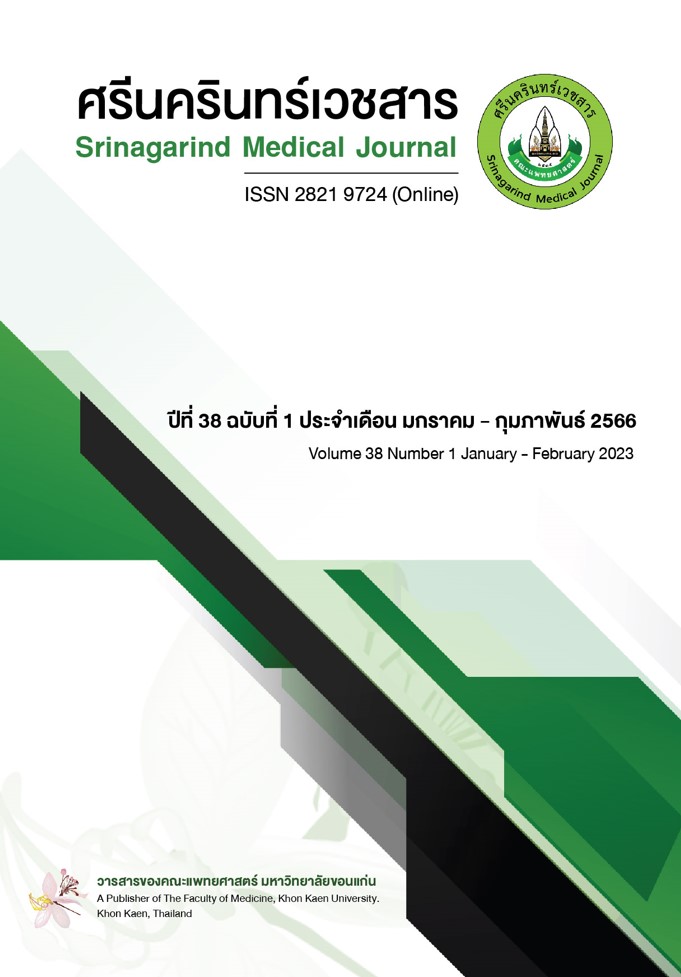การให้ยาเม็ดเสริมธาตุเหล็กในสตรีตั้งครรภ์ที่เป็น Heterozygous Hemoglobin E และ Homozygous Hemoglobin E ในโรงพยาบาลสกลนคร
Abstract
Oral Iron Supplementation in Pregnant Women with Heterozygous Hemoglobin E and Homozygous Hemoglobin E in Sakon Nakhon Hospital
Somnuk Apiwantanagul1*, Treewijit Mungpuklang1, Niyada Boonapai2
1 Department of Obstetrics and Gynecology Sakon NakhonHospital, Sakon Nakhon Province
2 Community Nursing Department, Sakon Nakhon Hospital, Sakon Nakhon Province
หลักการและวัตถุประสงค์: สตรีตั้งครรภ์ที่มีฮีโมโกลบินผิดปกติแบบเฮเทอโรซัยกัสฮีโมโกลบินอีและโฮโมซัยกัสฮีโมโกลบินอี (heterozygous hemoglobin E (hemoglobin E thalassemia) and homozygous hemoglobin E thalassemia) มีโอกาสเกิดภาวะโลหิตจาง ที่อาจส่งผลกระทบต่อสตรีตั้งครรภ์และทารก โดยเพิ่มอัตราการป่วยและการเสียชีวิต การให้ยาเม็ดเสริมธาตุเหล็กเป็นอีกวิธีการที่ใช้ในการรักษาและป้องกันการเกิดโลหิตจางในสตรีตั้งครรภ์ ดังนั้นการศึกษานี้จึงมีวัตถุประสงค์เพื่อเปรียบเทียบปริมาณฮีโมโกลบิน (hemoglobin: Hb) ที่เปลี่ยนไปหลังจากได้รับยาเม็ดเสริมธาตุเหล็ก
วิธีการศึกษา: เป็นการวิจัยเชิงทดลอง ชนิดสุ่มเลือก 3 กลุ่ม ๆ ละ 22 ราย ในสตรีตั้งครรภ์ที่เป็นเฮเทอโรซัยกัสฮีโมโกลบินอีและโฮโมซัยกัสฮีโมโกลบินอี ที่มาฝากครรภ์ในโรงพยาบาลสกลนคร ในช่วงเดือนธันวาคม พ.ศ. 2564 ถึง กันยายน พ.ศ. 2565 จำนวน 66 ราย เครื่องมือที่ใช้ คือ แบบสอบถาม วิเคราะห์ข้อมูลโดยใช้สถิติเชิงพรรณนา การทดสอบไคสแควร์ (Chi-square test) และ One - way AN0VA โดยกำหนดค่านัยสำคัญทางสถิติที่ p < 0.05
ผลการศึกษา: สตรีตั้งครรภ์ที่มีฮีโมโกลบินอี จำนวน 66 ราย เป็นเฮเทอโรซัยกัสฮีโมโกลบินอีร้อยละ 78.8 และ โฮโมซัยกัสฮีโมโกลบินอี ร้อยละ 21.2 ค่าเฉลี่ยฮีโมโกลบินในการตรวจเลือดครั้งแรก คิดเป็น 11.8 กรัม/เดซิลิตร และครั้งที่สอง คิดเป็น 11.1 กรัม/เดซิลิตรโดยในกลุ่มที่ 1 (ได้รับยาเม็ดไตรเฟอร์ดีน 1 เม็ด) คิดเป็น 12.0 กรัม/เดซิลิตร และ 11.1 กรัม/เดซิลิตรกลุ่มที่ 2 (ได้รับยาเม็ดไตรเฟอร์ดีน 1 เม็ดและ เฟอร์รัสฟูมาเรต 1 เม็ด) คิดเป็น 12.1 กรัม/เดซิลิตร และ 11.4 กรัม/เดซิลิตร และ กลุ่มที่ 3 (ได้รับยาเม็ดไตรเฟอร์ดีน 1 เม็ดและ เฟอร์รัสฟูมาเรต 2 เม็ด) คิดเป็น 11.3 กรัม/เดซิลิตร และ 10.8 กรัม/เดซิลิตรตามลำดับ เมื่อเปรียบเทียบการเปลี่ยนแปลงค่าฮีโมโกลบินโดยใช้สถิติไคสแควร์ พบว่ามี 2 กลุ่มที่มีความแตกต่างในการเปลี่ยนแปลงค่าฮีโมโกลบินอย่างมีนัยสำคัญทางสถิติ คือ กลุ่มที่ 1 มีฮีโมโกลบินเพิ่มขึ้นร้อยละ 86.4 มากกว่าฮีโมโกลบินลดลงร้อยละ 13.6 (p=0.01) และกลุ่มที่ 3 มีฮีโมโกลบินเพิ่มขึ้นร้อยละ 27.3 น้อยกว่าฮีโมโกลบินลดลงร้อยละ 73.7 (p=0.02)
สรุป: ควรมีการตรวจหาภาวะขาดธาตุเหล็กในหญิงตั้งครรภ์ที่มี Hb E thalassemia เพื่อให้การรักษาที่เหมาะสมเพื่อไม่ให้สตรีตั้งครรภ์ที่มี Hb E thalassemia ที่มีการขาดธาตุเหล็ก ทำให้มีผลต่อผลลัพธ์การตั้งครรภ์โดยเฉพาะ การเจริญเติบโตช้าของทารกในครรภ์ (IUGR) และการเกิดภาวะเจ็บครรภ์คลอดก่อนกำหนดได้ จึงควรมีการตรวจค้นหาภาวการณ์ขาดธาตุเหล็กอย่างเหมาะสม เพื่อให้การรักษาและป้องกันการขาดธาตุเหล็กในไตรมาสที่ 1 และ 3 (ที่อายุครรภ์ 12 สัปดาห์ และ 32 สัปดาห์) ในสตรีตั้งครรภ์ที่มี Hb E thalassemia ที่มีโลหิตจาง (Hb < 11 g/dl)
HbE are more likely to develop anemia. This may affect pregnant women and the fetus leading to increased morbidity and mortality rates. Iron supplements have been widely deployed to prevent anemia in pregnant women. Therefore, this study aimed to compare the change of hemoglobin (Hb) after receiving various iron supplements in pregnant women with heterozygous HbE and homozygous HbE.
Methods: This vandomized controlled trial was conducted on 66 pregnant women with thalassemia Hb E from December 2021 to September 2022 in Sakon Nakhon hospital. Data were collected at antenatal care by questionnaires. The demographic data were analyzed using descriptive statistics, Chi-square test and One - way ANOVA.
Results: Amongst 66 pregnant women, they were characterized as 78.8% heterozygous HbE and 21.2% homozygous HbE. The average Hb concentration in the first blood test was 11.8 g/dl (Min = 9.2, Max = 14.2, S.D. = 1.0), and the second blood test was 11.1 g/dl (Min = 9.1, Max = 13.1, S.D. = .9). The average Hb levels in the first and second blood tests of group I, who received 1 tablet of triferdine were 12.0 g/dl and 11.1 g/dl; group II received 1 tablet of triferdine and 1 tablet of ferrous fumarate, which showed 12.1 g/dl and 11.4 g/dl; and group III received 1 tablet of triferdine and 2 tablets of ferrous fumarate, representing 11.3 g/dl and 10.8 g/dl, respectively. The changes in hemoglobin concentration using Chi-square test revealed that 86.4% of group I had statistically significant increased Hb level while 13.6% were decreased (p=0.01). Interestingly, 27.3% of group III showed an increase in Hb level with a decrease at 73.7% (p=0.02).
Conclusion: Iron deficiency should be screened for pregnant women with Hb E thalassemia in order to provide appropriate treatment to rule out iron deficiency in pregnant women with Hb E thalassemia. Thus affecting pregnancy outcomes in particular intrauterine growth retardation (IUGR) and preterm labor. Therefore, appropriate detection of iron deficiency should be undertaken, to treat and prevent iron deficiency in the first and third trimesters (at 12 weeks and 32 weeks of gestation) in pregnant women with Hb E thalassemia with anemia (Hb < 11 g/dl)
Downloads
Published
Issue
Section
License

This work is licensed under a Creative Commons Attribution-NonCommercial-NoDerivatives 4.0 International License.


